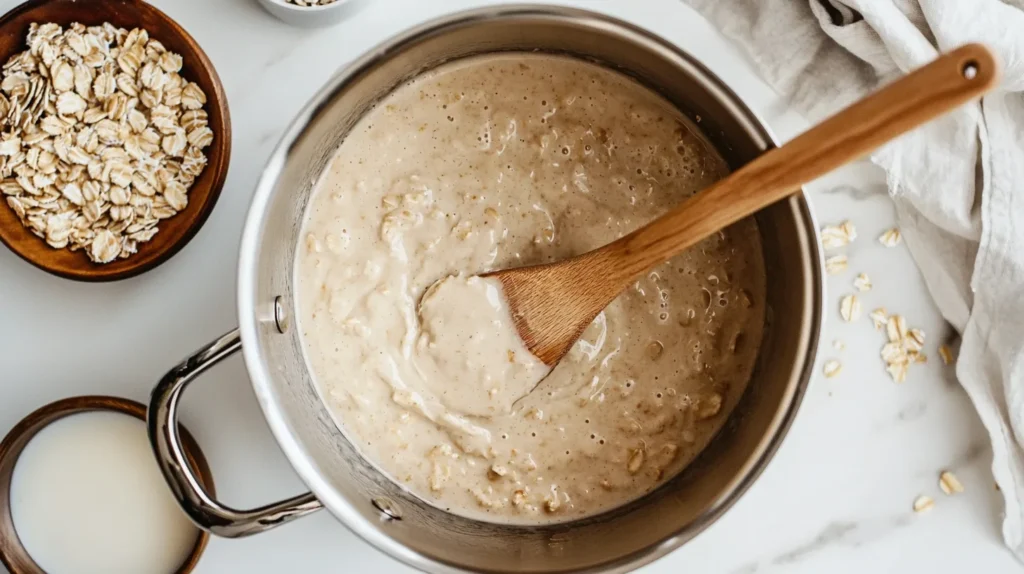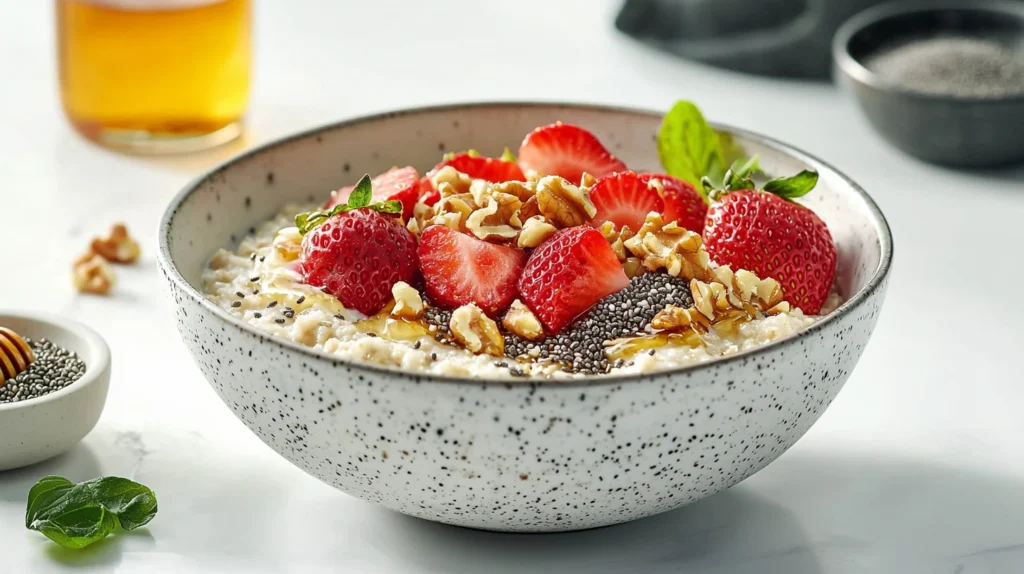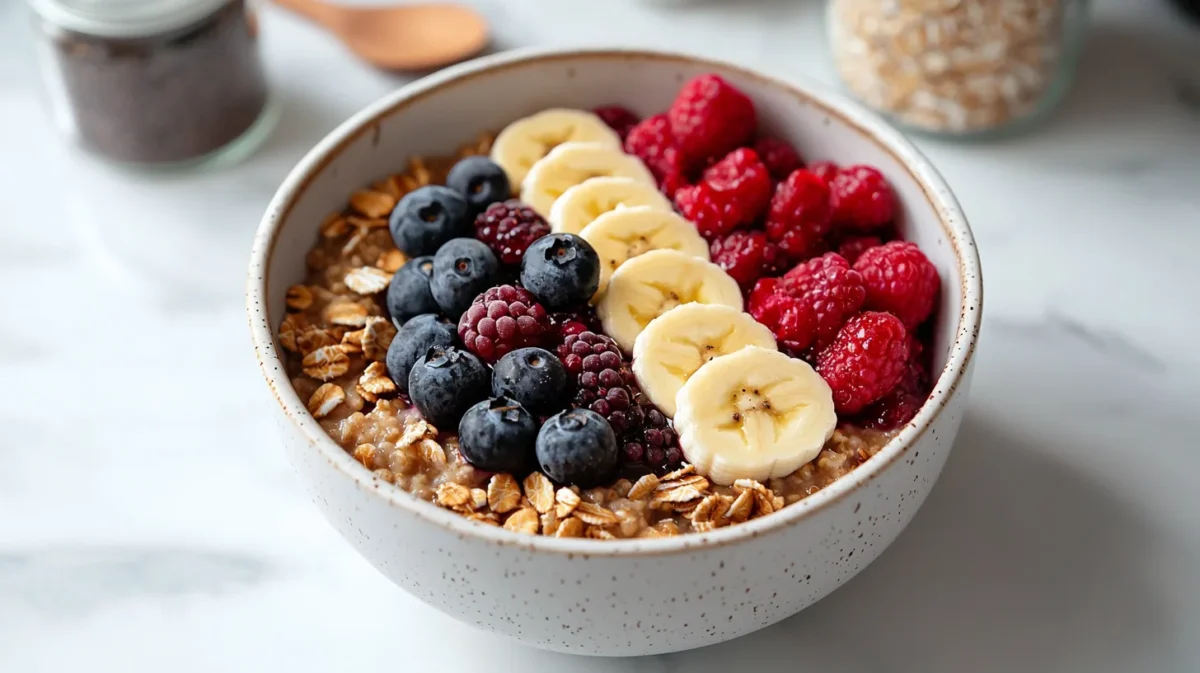Oatmeal is a breakfast favorite, but have you ever wondered, Is oatmeal gluten-free and dairy-free? It’s a question that stumps many, especially those trying to stick to specific diets. The good news? With the right choices, oatmeal can fit perfectly into your gluten-free and dairy-free lifestyle, bringing ease and joy to your mornings.
First, let’s talk about why oatmeal is so popular. It’s quick, comforting, and packed with nutrients to kick-start your day. Next, it’s super versatile—whether you like it sweet, savory, or somewhere in between, there’s a way to make oatmeal your new best friend without much effort.
Here’s the best part: finding gluten-free and dairy-free options isn’t as tricky as you think. Keep reading, and you’ll discover simple tips, trusted brands, and creative ways to enjoy this healthy breakfast staple. Let’s dig in together!
Table of Contents
Understanding the Basics of Oatmeal’s Gluten-Free and Dairy-Free Status
What Makes Oatmeal a Naturally Safe Option?
Oatmeal is naturally gluten-free because oats themselves do not contain gluten. Gluten is a protein found in wheat, barley, and rye. However, oats are often grown or processed near these grains, which can lead to contamination. Learn more about what people on gluten-free and dairy-free diets eat in our detailed guide: What Do Dairy-Free Gluten-Free People Eat?.
First, choosing oats labeled “gluten-free” ensures they were processed in dedicated facilities.

Next, it guarantees no contact with gluten-containing grains, making it a safe option. Many brands now prioritize clean production practices to meet this growing demand.
Also, oats are inherently dairy-free, so they work well for those avoiding milk. With the right choices, you can enjoy a hearty, gluten-free breakfast without worry. You’re going to love how easy it is to make a safe, delicious meal. Try certified gluten-free oats today and see the difference they can make!
Checking for Hidden Ingredients in Packaged Oats
Packaged oatmeal can sometimes contain hidden sources of gluten or dairy. This happens when brands add flavorings or mix-ins like cream or malt. To avoid these surprises, read labels carefully. Look for clear allergen statements and certifications for gluten-free or dairy-free processing.
First, check for phrases like “contains wheat” or “may contain milk.” Then, ensure no hidden ingredients like malt extract, which often contains gluten. Many flavored oatmeals use powdered milk or butter for creaminess, so be cautious.
Next, opt for plain oats and add your toppings to stay safe. Thankfully, brands have become better at transparency, making it easier for consumers to trust their products. Avoiding hidden allergens might feel tricky at first, but with practice, it becomes second nature. For more tips on avoiding gluten in other foods, read our article on What Can I Eat Gluten-Free and Dairy-Free for Breakfast? Sticking to plain, certified oats is a foolproof way to enjoy a safe, hearty bowl of oatmeal.
How to Choose Certified Gluten-Free and Dairy-Free Oatmeal Brands
Essential Labels to Look for on Oatmeal Products
Shopping for gluten-free and dairy-free oatmeal can feel overwhelming, but it’s simpler than you think. Start by looking for certification labels like “Certified Gluten-Free” or “Dairy-Free.” These labels confirm that the oats were processed in facilities free from wheat, barley, rye, and milk contamination.
First, check for allergen warnings on the packaging. Then, read the ingredients list for added flavorings or milk derivatives. Some brands include a “cross-contamination” warning, which helps you decide if the product is safe for your needs.
In addition, brands with third-party testing offer extra reassurance about their safety standards. Another tip is to buy from brands with a reputation for allergen-friendly foods. Understand the FDA standards for gluten-free labeling here. Doing this reduces the guesswork and helps you feel confident about your choices.
Check out our related content on certified breakfast options: Gluten-Free Dairy-Free Breakfast Ideas. With these tips, finding safe oatmeal is easier than ever. Don’t miss out—start shopping smart today!

Trusted Brands Offering Safe Oatmeal Options
When it comes to oatmeal, some brands stand out for their commitment to gluten-free and dairy-free products. Bob’s Red Mill is a favorite, offering certified gluten-free oats processed in dedicated facilities. Another popular choice is Purely Elizabeth, which provides both safety and delicious flavor combinations.
Quaker now offers a gluten-free line, though you’ll need to double-check for flavor additives. First, research each brand’s allergen policy to ensure they meet your needs. Then, try smaller, niche companies that specialize in allergen-friendly foods. Many of these brands use transparent labeling to make shopping easier.
You can also explore online reviews to see what other consumers recommend. With so many options, you’re bound to find a favorite that works for your lifestyle. Give these trusted brands a try, and you’ll see that eating gluten-free and dairy-free can still be delicious!
For more tips, recipes, and updates, follow us on Facebook and Instagram. We’d love to connect with you!
Understanding Cross-Contamination Risks
How Cross-Contamination Happens in Oats
Cross-contamination occurs when gluten-containing grains like wheat or barley come into contact with oats during farming or processing. This is a common concern for anyone asking, Is oatmeal gluten-free and dairy-free?
First, oats are often grown in fields near other grains, which can lead to accidental mixing. Then, during processing, shared equipment can introduce gluten or dairy into otherwise safe oats. Many factories do not have dedicated lines for gluten-free products, increasing the risk further.
In addition, cross-contamination can happen during transportation or packaging. Certified gluten-free oats are processed in facilities that avoid these risks, making them a safer choice. Always check for clear certifications on the label to ensure your oatmeal is truly safe.
Understanding how cross-contamination happens helps you make better choices. Stick to certified brands to enjoy worry-free oatmeal every time! If you’re interested in avoiding cross-contamination in other dishes, explore: Are Eggs Gluten-Free and Dairy-Free?.
Steps to Keep Your Kitchen Allergen-Free
Even at home, cross-contamination can pose a significant risk if you’re not careful. To keep your oatmeal gluten-free and dairy-free, start by using separate cooking utensils for allergen-free meals.
First, wash all pots, pans, and spoons thoroughly before cooking any meals. Then, store your oats in airtight containers to prevent accidental exposure to other grains or contaminants. Avoid using the same scoops for different ingredients, as this can mix harmful contaminants.
In addition, always double-check labels when buying new products or trying new brands. Even small traces of gluten or dairy can cause serious reactions for sensitive individuals. Keeping your kitchen clean and organized helps you stay safe without much effort. You’ve got this! With just a little extra care, you can enjoy a delicious bowl of oatmeal without any worries. Try these simple tips today and see how easy it is to protect your food.
Nutritional Benefits of Gluten-Free and Dairy-Free Oatmeal
Why Oatmeal Is a Healthy Breakfast Choice
Gluten-free and dairy-free oatmeal is a fantastic way to start your day. First, it’s packed with whole grains, which provide lasting energy and keep you full longer.
Oats are also naturally rich in fiber, helping to support healthy digestion and maintain steady blood sugar levels. This makes oatmeal a perfect choice for anyone looking for a balanced, wholesome breakfast.
In addition, oats contain essential nutrients like magnesium, iron, and zinc, which contribute to overall health. Unlike many processed breakfast options, oatmeal is a natural, minimally processed food that nourishes your body.
By choosing certified gluten-free and dairy-free oats, you avoid allergens while still getting these amazing benefits. Plus, it’s so versatile that you can make it your own by adding your favorite toppings. Whether you prefer fruit, nuts, or spices, oatmeal is a customizable breakfast that truly works for everyone.
Key Nutrients Found in Oatmeal
Oatmeal is loaded with essential nutrients that support a healthy body. First, it’s a great source of complex carbohydrates, which provide energy to power you through your morning.
Then, the high fiber content helps with digestion and keeps you feeling full for hours. Oats are also rich in vitamins like B1 and minerals like manganese, which are vital for energy production and bone health.
In addition, they contain antioxidants called avenanthramides, which are unique to oats and help reduce inflammation. For those on gluten-free and dairy-free diets, oatmeal offers a safe and nutritious way to meet daily nutrient needs.
By choosing certified oats, you can enjoy these benefits without worrying about allergens. Whether you’re starting your day or looking for a mid-day energy boost, oatmeal is a nutrient-packed option that delivers on taste and health. Try it today and feel the difference!
Creative Ways to Enjoy Gluten-Free and Dairy-Free Oatmeal
Flavorful Toppings and Mix-Ins to Try
One of the best things about oatmeal is how easy it is to customize. Gluten-free and dairy-free oatmeal doesn’t have to be boring—it’s a blank canvas for your favorite flavors!
First, try topping it with fresh fruits like berries, bananas, or apples for natural sweetness. Then, sprinkle in nuts or seeds for a satisfying crunch and extra protein.
You can also add a spoonful of almond butter or coconut yogurt for creaminess without dairy. For a touch of indulgence, try mixing in dark chocolate chips or a drizzle of maple syrup.
In addition, spices like cinnamon, nutmeg, or vanilla extract can transform your oatmeal into a cozy treat. With so many options, you’ll never get bored of your morning bowl. Have fun experimenting and finding your perfect combination. Oatmeal is the kind of breakfast that’s as exciting as you make it!
Savory Oatmeal Recipes for a Unique Twist
Who says oatmeal has to be sweet? Savory oatmeal is a fun and delicious way to switch things up. First, cook your oats with vegetable broth instead of water or milk to create a savory base.
Then, top them with sautéed veggies like spinach, mushrooms, or cherry tomatoes for a hearty meal. In addition, you can add plant-based proteins like tofu, chickpeas, or a fried egg substitute for extra nutrition.
For seasoning, try a sprinkle of nutritional yeast, garlic powder, or a pinch of salt and pepper. Who says oatmeal has to be sweet? For a savory spin, check out this recipe for a savory breakfast staple: Crab Omelette Recipe. Savory oatmeal is not only satisfying but also packed with nutrients that keep you energized.
It’s perfect for lunch or dinner, too! Don’t be afraid to get creative and make it your own. Give savory oatmeal a try—it might just become your new favorite way to enjoy this versatile dish!
Debunking Myths About Gluten-Free and Dairy-Free Oatmeal
Can People with Allergies Eat Oatmeal?
For many people with food allergies, oatmeal can be a safe and enjoyable choice. However, questions like Is oatmeal gluten-free and dairy-free? often arise due to concerns about contamination.
Certified gluten-free oats are safe for most people with celiac disease or gluten sensitivity. First, these oats are processed in facilities that eliminate cross-contamination with wheat, barley, or rye. Then, they’re tested to meet strict gluten-free standards.
For dairy allergies, oatmeal is naturally dairy-free, as oats contain no milk proteins. Just watch out for flavored varieties that may include cream powders or butter.
In addition, some individuals with oat allergies may experience reactions, so it’s essential to listen to your body. When in doubt, consult with a healthcare professional before adding oatmeal to your diet. With the right precautions, oatmeal can be a safe and nourishing option for most.
Myths About Gluten-Free Grains Debunked
There are many misconceptions about gluten-free grains, and oats often find themselves at the center of debates. Some believe oats naturally contain gluten, but this is not true.
Gluten-free oats are free of wheat, barley, and rye proteins. The confusion comes from cross-contamination during farming or processing. Certified gluten-free oats, however, are produced under strict conditions to avoid these issues.
Concerns about their safety often stem from misinformation rather than fact. Another myth is that gluten-free grains are less nutritious. Oats, in particular, are packed with essential nutrients like fiber, vitamins, and minerals. They’re just as healthy—if not healthier—than many gluten-containing grains.
By debunking these myths, you can confidently enjoy oatmeal as part of your diet. To expand your knowledge, consider reading: What Are the Disadvantages of Lupin Flour?. Don’t let misconceptions hold you back. Embrace the simplicity and nourishment that gluten-free oatmeal brings to the table!
Frequently Asked Questions (FAQs)
Is oatmeal gluten and dairy free?
Oatmeal is naturally gluten-free and dairy-free, but processing matters. Oats do not contain gluten or dairy, making them great for many diets. However, cross-contamination can occur when oats are processed near gluten-containing grains.
To ensure safety, look for oats labeled “certified gluten-free.” These oats are processed in dedicated facilities, reducing contamination risks. Plain oats are naturally dairy-free, but flavored varieties might include milk powders or cream-based additives.
Always check labels and opt for certified oats to enjoy oatmeal confidently. It’s a simple, safe, and delicious breakfast you can easily customize!
Are oats dairy free?
Yes, oats are naturally dairy-free, making them a great choice for those avoiding milk. Since oats are plant-based, they don’t contain any dairy or lactose. However, watch out for flavored or pre-packaged oat products.
Some flavored oatmeal varieties include added milk powders, creamers, or dairy-based flavorings. To stay safe, choose plain oats or check labels for phrases like “contains milk.” Certified oats labeled dairy-free are a great option for extra peace of mind.
With plain oats, you can enjoy a creamy breakfast without worrying about dairy. Add plant-based toppings for more flavor!
Is the oatmeal gluten-free?
Oatmeal can be gluten-free, but it depends on how it’s processed. Oats themselves don’t contain gluten, which makes them safe for many. However, cross-contamination occurs when processors handle oats near gluten-containing grains like wheat or rye.
To ensure your oatmeal is gluten-free, always look for the “certified gluten-free” label. This certification means the oats were processed in facilities that avoid contamination. Plain oats are typically the safest choice, as flavored varieties might include gluten-containing ingredients.
By choosing certified gluten-free oats, you can enjoy oatmeal confidently. It’s an easy, delicious way to stick to a gluten-free diet!
Can you eat oats if you are gluten-free?
Yes, you can eat oats if you are gluten-free, but choose carefully. Oats themselves are naturally gluten-free, making them a good option for many people avoiding gluten. However, cross-contamination with wheat, barley, or rye during processing can be an issue.
To stay safe, select oats labeled “certified gluten-free.” These oats are processed in dedicated facilities to minimize contamination. Plain oats are often the safest choice, as flavored options may contain gluten-containing ingredients.
By opting for certified oats, you can enjoy a nutritious and gluten-free breakfast confidently. Add your favorite toppings and make it your own! Looking for other gluten-free breakfast staples? Discover ideas like What Is the Most Famous Omelette?.
Enjoying Oatmeal Confidently: A Delicious Gluten-Free and Dairy-Free Choice
Oatmeal is a comforting, versatile, and healthy way to start your day. For anyone asking, Is oatmeal gluten-free and dairy-free? the answer is yes, with the right choices. Certified gluten-free and dairy-free oats are widely available, making it simple to enjoy this breakfast staple safely.
First, remember to check for certifications and avoid flavored varieties with hidden ingredients. Then, try fun toppings or savory twists to keep things exciting. Whether you prefer fresh fruit, crunchy nuts, or creamy plant-based additions, oatmeal offers endless possibilities.
With its natural nutrients, fiber, and energy-boosting benefits, oatmeal is a great option for almost everyone. It’s easy to prepare, completely customizable, and perfect for busy mornings or relaxed weekends.
So, grab your favorite oats and start experimenting. You’re going to love how simple and delicious it is. Don’t wait—give gluten-free and dairy-free oatmeal a try today!
We’d love to hear your thoughts on this article! Leave a comment below and let us know how you enjoy oatmeal in your gluten-free and dairy-free lifestyle.

